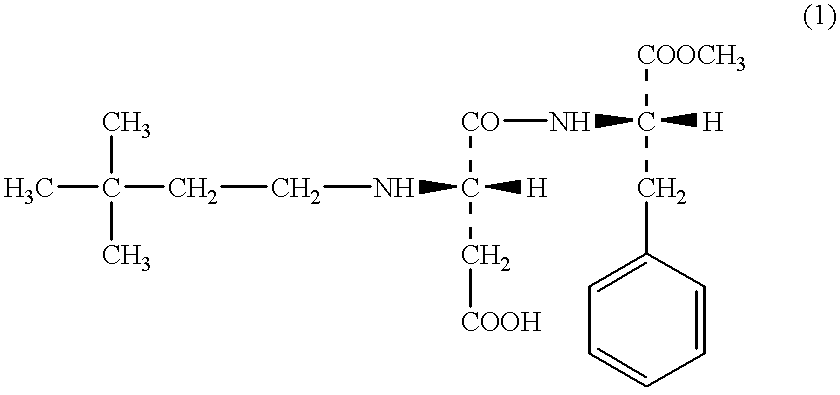Process for purification or recovery of sweetener
a sweetener and purification technology, applied in the field of new products, can solve the problems of difficult to say that chromatography is an efficient technique in view of yield, and is not efficient from the recovery rate (yield) and other issues
- Summary
- Abstract
- Description
- Claims
- Application Information
AI Technical Summary
Problems solved by technology
Method used
Image
Examples
example 1
The crystals consisting of 4.5 g of .alpha.-L-aspartyl-L-phenylalanine methyl ester and 10 g of N-(3,3-dimethylbutyl)-.alpha.-L-aspartyl-L-phenylalanine methyl ester were added to the mixed solvents consisting of 1000 ml of ethyl acetate and 500 ml of water, and the mixture was stirred at room temperature. The crystals were completely dissolved in the solution, and then the mixture was further stirred for 25 minutes. The mixture was allowed to stand for 5 minutes to make 2 layers separated in the solution. Thus obtained organic layer was washed with 100 ml of water and concentrated under reduced pressure to give 9.1 g of white crystals. In the crystals, .alpha.-L-aspartyl-L-phenylalanine methyl ester was not contained. The recovery yield of N-(3,3-dimethylbutyl)-.alpha.-L-aspartyl-L-phenylalanine methyl ester was 91%.
example 2
To the mixed solvents of 500 ml of toluene and 100 ml of water, the crystals consisting of 4.5 g of .alpha.-L-aspartyl-L-phenylalanine methyl ester and 10 g of N-(3,3-dimethylbutyl)-.alpha.-L-aspartyl-L-phenylalanine methyl ester were added, and thus obtained mixture was stirred at 50.degree. C. After confirming the fact that the crystals have been dissolved completely in the solution, the mixture was further stirred for 10 minutes. The mixture was allowed to stand for 5 minutes to make 2 layers separated in the solution. Thus obtained organic layer was washed with 20 ml of water, and concentrated under reduced pressure to obtain 9.3 g of white crystals. In the crystals, .alpha.-L-aspartyl-L-phenylalanine methyl ester was not contained. The recovery yield of N-(3,3-dimethylbutyl)-.alpha.-L-aspartyl-L-phenylalanine methyl ester was 93%.
example 3
To the mixed solvents of 1000 ml of toluene and 100 ml of water, the crystals consisting of 4.5 g of .alpha.-L-aspartyl-L-phenylalanine methyl ester and 10 g of N-(3,3-dimethylbutyl)-.alpha.-L-aspartyl-L-phenylalanine methyl ester were added, and thus obtained mixture was stirred at 50.degree. C. The crystals were dissolved completely in the solution, and then the mixture was further stirred for 10 minutes. The mixture was allowed to stand for 5 minutes to make 2 layers separated in the solution. Thus obtained organic layer was concentrated under reduced pressure to obtain 9.5 g of white crystals. Thus obtained crystals were recrystallized in the water to obtain 8.8 g of N-(3,3-dimethylbutyl)-.alpha.-L-aspartyl-L-phenylalanine methyl ester. In the crystals, .alpha.-L-aspartyl-L-phenylalanine methyl ester was not contained. The recovery yield thereof was 88%.
PUM
| Property | Measurement | Unit |
|---|---|---|
| temperature | aaaaa | aaaaa |
| temperature | aaaaa | aaaaa |
| concentrations | aaaaa | aaaaa |
Abstract
Description
Claims
Application Information
 Login to View More
Login to View More - R&D
- Intellectual Property
- Life Sciences
- Materials
- Tech Scout
- Unparalleled Data Quality
- Higher Quality Content
- 60% Fewer Hallucinations
Browse by: Latest US Patents, China's latest patents, Technical Efficacy Thesaurus, Application Domain, Technology Topic, Popular Technical Reports.
© 2025 PatSnap. All rights reserved.Legal|Privacy policy|Modern Slavery Act Transparency Statement|Sitemap|About US| Contact US: help@patsnap.com

